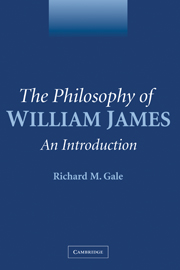Book contents
- Frontmatter
- Contents
- Preface
- Introduction
- PART I THE PROMETHEAN PRAGMATIST
- PART II THE PASSIVE MYSTIC
- 8 The Self
- 9 The I–Thou Quest for Intimacy and Religious Mysticism
- 10 The Humpty Dumpty Intuition and Backyard Mysticism
- 11 An Attempt at a One World Interpretation of James
- Bibliography of Works Cited
- Suggested Further Readings
- Index
10 - The Humpty Dumpty Intuition and Backyard Mysticism
Published online by Cambridge University Press: 06 January 2010
- Frontmatter
- Contents
- Preface
- Introduction
- PART I THE PROMETHEAN PRAGMATIST
- PART II THE PASSIVE MYSTIC
- 8 The Self
- 9 The I–Thou Quest for Intimacy and Religious Mysticism
- 10 The Humpty Dumpty Intuition and Backyard Mysticism
- 11 An Attempt at a One World Interpretation of James
- Bibliography of Works Cited
- Suggested Further Readings
- Index
Summary
The previous two chapters have presented the first two legs of James's journey to find a cozy personal world with which he could establish an intimate communion because it would answer back to his deepest inner feelings and emotions. It began with his attempt to be intimate with himself through an introspective analysis of what made him one and the same self from one time to another. Next, he attempted to be intimate with others, be it man, beast, nature, or God, through a special type of I–Thou experience that partially unified him with their inner conscious life. To achieve this sort of mystical intimacy James found it necessary to conquer his promethean self.
This chapter will explore the third and final leg in his journey in which he cultivates a backyard mysticism based on conceptless intuition of the temporal flux. Whereas his religious mysticism was based on an effort to I–Thou other selves, most importantly supernatural ones, backyard mysticism is directed at the most mundane sort of individuals – the contents of our ordinary sense experience of the temporal flux – but it sees them in a new, mystical manner as mushing together in just the way that successive conscious states of a person do, which served as the basis for self-identity over time. Thus, what we find upon introspecting our own consciousness is the way that things, in general, are in the world. This results not just in panpsychism but spiritualism.
- Type
- Chapter
- Information
- The Philosophy of William JamesAn Introduction, pp. 200 - 220Publisher: Cambridge University PressPrint publication year: 2004



